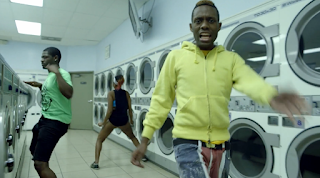To do so, Formation makes intense use of the concepts of intertextuality/referential codes and bricolage
The use of bricolage
Key term - intertextuality - Where a media product or text makes reference to another media product or text.
Key term - Bricolage - Where a media product is constructed with iconography and conventions from many other texts, creating entirely new meanings. Often used when discussing postmodern media products. An example of a media product that uses bricolage is a 'mashup'. For an excellent example of bricolage, check out Quentin Tarantino’s Kill Bill (2003)
Task - If possible, go through Formation and make screenshots of each of the different aesthetic and visual styles that the video demonstrates, including from different eras, settings and situations. Why is this video not just a dance routine in a studio? Why combine so many styles and themes?
New Orleans and bounce music
Task - watch That B.E.A.T (2014)
It's a fascinating, multi-award winning documentary, so make sure you check out the whole thing (it's only ten minutes long). The answer the following questions:
- What specific elements of iconography did the producers of Formation use from That B.E.A.T?
- What literal pieces of footage did the producers of Formation take from That B.E.A.T?
- Bounce music has a big LGBT following, and is fundamental to the LGBT scene in New Orleans. How many LGBT themes come through in That B.E.A.T? Why?
- Beyonce is a millionaire. Why is she using the themes and iconography of That B.E.A.T? Think carefully about this last one.
The antebellum era and slavery in the American south
The Antebellum era refers to a period of time of economic growth in the American South in the 19th Century, largely due to heavy industrialisation made possible by utilising black slave labour.
Task - Read this Wikipedia article, and make notes on the era.
The era was characterised not only by slavery, but also by the distinctive costumes owned by the slave owners, which you can read more about here. It is important to note that while these dresses are elaborate and beautiful, they have symbolic connotations of racism and the advocation of slavery, due to being worn by those who owned slaves.
Perhaps the most famous media product set in the Antebellum South is Viktor Flemming's 1939 historical epic Gone With The Wind, which is still the highest grossing film of all time when adjusted for inflation. A riches to rags to riches story, the film charts the collapse of the American South during its four hour running time, and explores the relationship between slave owners and slaves in a way that is guaranteed to make modern audiences uncomfortable.
The most prominent black character in Gone With The Wind is Mammy, played by Hattie McDaniel. She represents a black stereotype that many of us will be completely unfamiliar with. Brash, rough round the edges, uncultured, and unwaveringly loyal to the people who bought her and own her like a piece of property.
Task - watch this clip, where Mammy attempts to get Scarlett O'Hara, the protagonist of the film to eat something before a lavish party. In what ways are black people and white people represented in this scene?
Then check out this scene. In what ways are black people and white people represented? What binary oppositions are encoded through the iconography?
This era is directly referenced in formation. By how? And more importantly, Why?
Task - find as many images in Formation that make reference to the Antebellum era as possible, and answer the following question below.
Why does Beyonce, a black woman, dress in a costume associated with white slave owners? Consider as many reasons as possible. Here's a big hint.
Hurricane Katrina, media coverage and black lives matter
Task - research hurricane Katrina, and make as many notes as possible about the incident, including dates, and facts including the number of deaths and the economic impact.
Task - watch this compilation of media footage from hurricane Katrina. In what ways does Formation utilise the iconography of hurricane Katrina?
And, more importantly, why?





